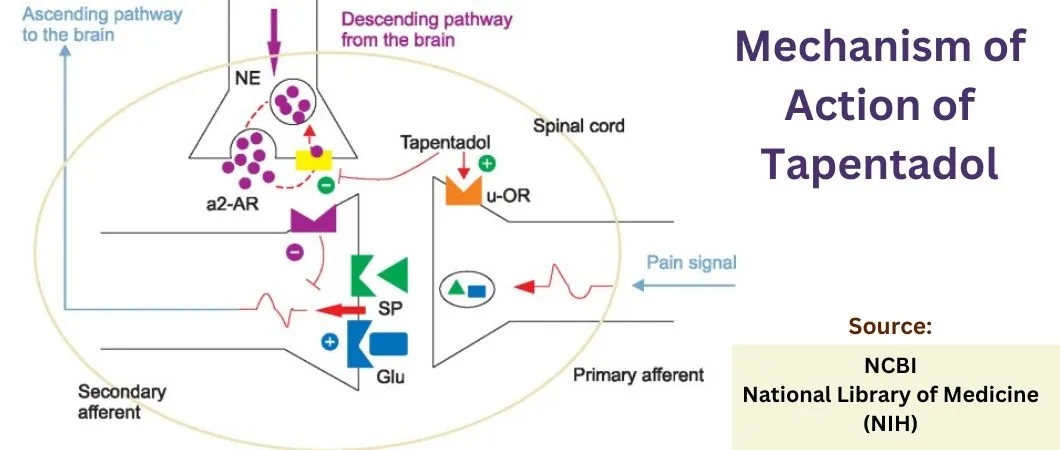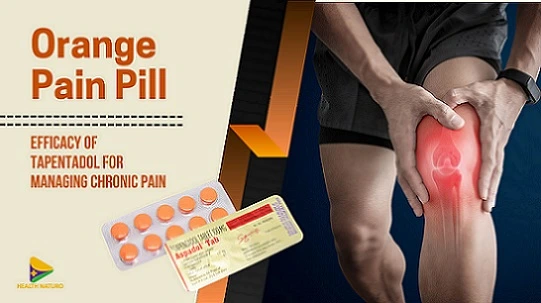The OM orange pill is identified as Tapentadol 100 mg which is available in numerous brand names. With an "OM" imprint on one side and "100" on the other, this orange pain pill is composed of Tapentadol 100 mg, which is the active compound and approved by the FDA for treating severe acute and chronic pain in people.
Wondering what the orange pain pill is or if there is a correlation with Tapentadol 100 mg? We have answers to all your questions.
Tapentadol 100 mg is an opioid analgesic that delivers faster relief from pain with two distinct mechanisms. It is often prescribed after an injury or surgery when conventional pain medications fail to relieve pain effectively.
So, let us have a brief insight into the uses, benefits, and safety profile of Tapentadol and why it is also called the “orange pain pill.”
What Are Orange Round Pills?
Tapentadol is also called the “Orange round pill” due to its distinct color. It is a centrally-acting oral analgesic approved by the FDA (US Food and Drug Administration) in 2008. The use of Tapentadol is proven effective for treating moderate to severe chronic and acute pain [1].
Tapentadol is a Schedule II controlled substance that may have a potential risk of abuse if not administered correctly. With a quicker onset of action, Tapentadol 100 mg begins to work within 30 minutes of intake [2].
Orange Pill Painkiller- Pill Identification

Tapentadol is a round orange pill with 100 on one side.
Tapentadol pill identification can be done based on the pill characteristics that are listed below [4]. This is significantly important for users who get Tapentadol online to ensure the quality and authenticity of the opioid tablet.
|
Tapentadol Orange Pill Characteristics |
|
|---|---|
|
Generic Name |
Tapentadol |
|
Inactive Compound |
Croscarmellose sodium, polyethylene glycol, lactose monohydrate, aluminum oxide, povidone, titanium dioxide, magnesium stearate, magnesium silicate, microcrystalline cellulose, and polyvinyl alcohol. |
|
Imprint |
O-M 100 |
|
Strength |
100 mg |
|
Color |
Orange |
|
Size |
9.00 mm |
|
Shape |
Round. |
Pill Package

The display content of the pill package indicates the ingredient list of the pill and its precautionary measures to ensure a lower risk of side effects [3].
Note- The Nucynta 100 mg pill package is from Collegium Pharmaceuticals and thus may differ depending on the manufacturing company. Some leading Tapentadol brand manufacturers are Signature Pharmaceuticals, Janssen Pharmaceuticals, and Cadila Pharmaceuticals.
Various Brand Drugs
It is further important to note that generic Tapentadol tablets are not available on the market. The popular Tapentadol brand drugs are Aspadol, Palexia, and Nucynta.
|
Brand name |
Manufacturer |
|---|---|
|
Aspadol Tablets |
Signature Pharmaceuticals Ltd. |
|
Grünenthal Ltd. |
|
|
Nucynta Tablets |
Collegium Pharmaceutical. |
These brand drugs are manufactured with Tapentadol Hydrochloride as the active compound. So, people can buy Aspadol or the other brand drugs of Tapentadol for effective pain management.
Mechanism Of Action Of Tapentadol Orange Pain Pill
Pre-clinical data on Tapentadol demonstrate two unique mechanisms of action responsible for its analgesic effect- mu-opioid receptor agonist activity and noradrenaline re-uptake inhibition [4].


Let us simplify the above diagram and look at how each of the substances plays a vital role in the analgesic profile of Tapentadol.
-
Glutamate (Glu)- Tapentadol inhibits glutamatergic synaptic transmission [5]. The glutamatergic synapses are crucial in transmitting itch and pain sensations [6]. Thus, inhibiting the transmission of glutamate helps stop the pain signals.
-
Mu-opioid receptor- Tapentadol binds to the MOR (mu-opioid receptor), but its affinity is 44-fold lower than morphine [7]. However, its analgesic efficiency is comparable to morphine for acute and chronic pain. When an opioid drug such as Tapentadol binds to the mu-opioid receptor, the interaction triggers chemical reactions that cause pain relief and a feeling of pleasure [8].
-
Alpha 2 adrenoreceptor and Substance P- Stimulating the α-2 receptors helps reduce the release of substance P (neurotransmitter and modulator of pain perception). In simple terms, the activation of Alpha 2 adrenoreceptor helps reduce the secretion of substance P, thus resulting in pain relief.
-
Norepinephrine- Some opioids, such as Tapentadol, regulate the inhibition of the uptake of norepinephrine and serotonin. As norepinephrine plays a key role in controlling pain, inhibiting its reuptake increases its level in the body, thus helping relieve body pain.
Tapentadol 100 Mg Orange Pill Dosage And Administration
The standard dose of Tapentadol or its brand drug is 100 mg. Immediate Release (IR) tablets can be taken three to four times a day, whereas extended-release (ER) tablets can be administered twice daily.
-
Dosing over 600 mg per day is not advisable [9].
-
It is an oral pill and should be swallowed as a whole without breaking or crushing the tablet. The use of Tapentadol 100 mg is not recommended in patients with severe renal and hepatic failure.
-
The bioavailability of Tapentadol is 32% after an oral administration; therefore, it can be taken with or without food [10].
-
A few precautionary measures that must be followed when taking Tapentadol 100 mg dosage is to avoid using the analgesic while drinking, pregnant, and breastfeeding.
Precautionary Warning-
Never share your OM orange pill dosage with others, especially someone with a history of abuse or addiction. Misuse of the opioid analgesic can result in overdosing and addiction. Before the discontinuation of the analgesic, tapering off the Tapentadol method is advised by most physicians to avoid withdrawal signs.
Orange Pill- Narcotic And DEA Classification
In 2008, Tapentadol was classified by the DEA (Drug Enforcement Administration) as a Schedule II controlled substance in the USA.
A few key factors to know while purchasing Aspadol or the other brand drugs of Tapentadol are-
-
These are prescription medications and are not available without a prescription.
-
Tapentadol has a risk of abuse and thus should be taken with caution.
-
Long-term use must be done under the supervision of a medical practitioner.
-
It can be purchased online from a licensed pharmacy.
-
Legal status of Tapentadol in other countries:
-
Australia (AU)- S8 (Controlled drug).
-
Canada (CA)- Schedule I.
-
UK- Class A (Schedule 2 CD).
-
Side Effects And Safety Profile
Tapentadol 100 mg is usually well tolerated but may result in vomiting, nausea, drowsiness, and dizziness [16]. Studies indicate that the orange pain pill does not directly increase serotonin levels. However, its ability to inhibit norepinephrine reuptake can indirectly elevate serotonin levels in the body. This results in serotonin syndrome, a severe drug reaction resulting in a rapid heartbeat, Muscle rigidity, high blood pressure, Dilated pupils, and loss of muscle coordination [11].
Other common side effects of Tapentadol are headache, drowsiness, anxiety, stomach pain, irritability, dry mouth, insomnia, abnormal dreams, and excessive tiredness [12].
Drug Interactions Of Tapentadol OM Orange Pill
The intake of other compounds and medications with Tapentadol may alter the drug's working mechanism, increasing the risk of experiencing severe side effects. Some medicines that should not be co-administered with the Orange painkiller are butorphanol, samidorphan, nalbuphine, pentazocine, and naltrexone. Taking Monoamine oxidase (MAO) inhibitors such as tranylcypromine, isocarboxazid, phenelzine, metaxalone, rasagiline, and procarbazine should be avoided up to 2 weeks from taking the last Tapentadol dosage. Some of the other drug interactions that should be taken into consideration while taking Tapentadol orange pain pill are-
-
The use of other opioid medications such as hydrocodone and codeine and muscle relaxants such as Soma 350 mg should be avoided.
-
Sleep medications, along with anti-anxiety drugs.
-
Cough syrups.
-
Marijuana or cannabis.
Our Final Thoughts On Tapentadol OM 100 Round Pill
It is important to note that not all orange pain pills are Tapentadol. Other pain medications, such as Methocarbamol, Adderall, and Cyclobenzaprine, are also orange in color. OM small round orange pill is specifically identified as Tapenatadol tablets.
To sum it up, we can say that Tapentadol 100 mg is an effective opioid analgesic that is often called the “Orange Pain Pill” due to its distinctive orange color.
Available in the Immediate-release formula and the Extended-release formula, the analgesic effectively treats both acute and chronic pain in users. With high tolerability, analgesic use is considered safe, with a lower risk of experiencing side effects.
The prescription use of Tapentadol for neuropathic pain and other non-cancer-associated pain is 3 to 4 times a day.

